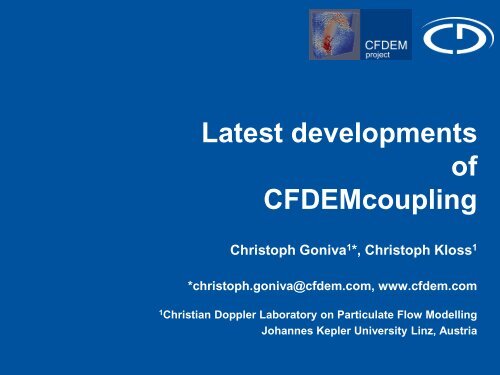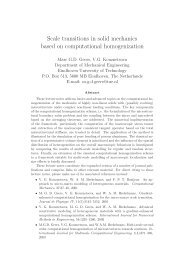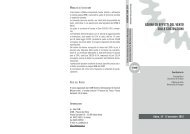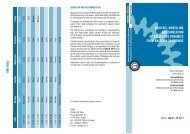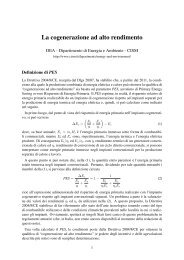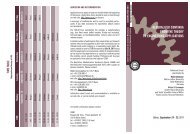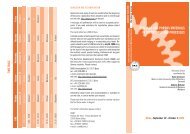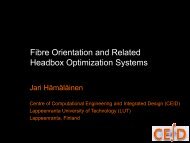Latest developments of the Open Source CFDEM project
Latest developments of the Open Source CFDEM project
Latest developments of the Open Source CFDEM project
- No tags were found...
You also want an ePaper? Increase the reach of your titles
YUMPU automatically turns print PDFs into web optimized ePapers that Google loves.
<strong>Latest</strong> Development <strong>of</strong> <strong>CFDEM</strong>couplingThe CommunityVibrant community has been established: <strong>CFDEM</strong><strong>project</strong> users compriseworld-class companies and dozens <strong>of</strong> universities and research institutes.S<strong>of</strong>tware used in 2 EU Projects (Pardem, ULCOS)S<strong>of</strong>tware used in <strong>project</strong>s with 6 out <strong>of</strong> 9 industrial partners <strong>of</strong> <strong>the</strong> CDLLIGGGHTS is now an <strong>of</strong>ficial Ubuntu Science PackageMEC Award for PhD <strong>the</strong>sis with highest industrial potential to C. Kloss<strong>CFDEM</strong> communityon www.cfdem.comhas 1200 users, and8600 unique site visitorsfrom 92 countrieswithin 8 monthsCD Laboratory on Particulate Flow Modelling, JKU Linzwww.jku.at/pfm5
Discrete Modelling <strong>of</strong> Fluid-ParticleSystems
Particulate FlowCFDDEM<strong>Latest</strong> Development <strong>of</strong> <strong>CFDEM</strong>couplingDiscrete Modelling <strong>of</strong> Fluid-Particle SystemsHow to model particulate flow?… as <strong>the</strong> romans said: “divide et impera”= +-(f1 + f2)af,1af,2= +-(f3 + f4)f1f2f4f3CFD with adaptedvoidfraction andmomentum sourcesDEM with force onparticles comingfrom CFDCD Laboratory on Particulate Flow Modelling, JKU Linzwww.jku.at/pfm8
<strong>Latest</strong> Development <strong>of</strong> <strong>CFDEM</strong>couplingModelling Fluid-Particle SystemsFluid-particle interactionComputational FluidDynamics (CFD)Discrete ElementMethod (DEM)• unresolved CFD-DEM• resolved CFD-DEMCD Laboratory on Particulate Flow Modelling, JKU Linzwww.jku.at/pfm
<strong>Latest</strong> Development <strong>of</strong> <strong>CFDEM</strong>couplingResolved CFD-DEMResolved CFD-DEMCD Laboratory on Particulate Flow Modelling, JKU Linzwww.jku.at/pfm
<strong>Latest</strong> Development <strong>of</strong> <strong>CFDEM</strong>couplingResolved CFD-DEM• Dynamic local mesh refinement: The overall mesh is as coarse as <strong>the</strong> flow problem permits The mesh in <strong>the</strong> particle-covered area is refined• Implemented in <strong>Open</strong>FOAM®CD Laboratory on Particulate Flow Modelling, JKU Linzwww.jku.at/pfm
<strong>Latest</strong> Development <strong>of</strong> <strong>CFDEM</strong>couplingResolved CFD-DEM• Rotating bodyu = U + ω × ru … particle velocityU … translational velocityr … positon vector wrt. body center… angular velocity incorporation <strong>of</strong> <strong>the</strong> rotationalcomponentCD Laboratory on Particulate Flow Modelling, JKU Linzwww.jku.at/pfm
<strong>Latest</strong> Development <strong>of</strong> <strong>CFDEM</strong>couplingUnresolved CFD-DEMUnresolved CFD-DEMCD Laboratory on Particulate Flow Modelling, JKU Linzwww.jku.at/pfm
<strong>Latest</strong> Development <strong>of</strong> <strong>CFDEM</strong>couplingDiscrete Modelling <strong>of</strong> Fluid-Particle SystemsDiscrete Modeling <strong>of</strong> fluid particle systems comes indifferent flavors…• CFD-DEM 1,2• coarse grained CFD-DEM 3• CFD-DDPM 4• MP-PIC 5,6Topic <strong>of</strong> this talk1) Goniva, C., Kloss, C., Deen, N.G., Kuipers, J.A.M. and Pirker, S. (2012): “Influence <strong>of</strong> Rolling FrictionModelling on Single Spout Fluidized Bed Simulations”, Particuology, DOI 10.1016/j.partic.2012.05.0022) Z.Y. Zhou, S.B. Kuang, K.W. Chu and A.B. Yu (2010) : “Discrete particle simulation <strong>of</strong> particle-fluid flow:Model formulations and <strong>the</strong>ir applicability”, Journal <strong>of</strong> Fluid Mechanics 661, 482-510.3) Radl S., Radeke, Ch., Khinast, J., Sundaresan, S. (2011) : ”Parcel-Based Approach for <strong>the</strong> Simulation <strong>of</strong>Gas-Particle Flows” , Proc. CFD 2011 Conference, Trondheim, Norway4) Fluent® Manual5) Andrews, M.J., O’Rourke, P.J. (1996): “The multi-phase particle-n-cell (MP-PIC) method for denseparticle flow”, Int. J. Multiphase Flow, 22, 379-4026) Benyahia, S., Sundaresan, S. (2012): “Do we need sub-grid corrections for both continuum and discretegas-particle flow models”, Powder Technology, 220, 2-6CD Laboratory on Particulate Flow Modelling, JKU Linzwww.jku.at/pfm15
<strong>Latest</strong> Development <strong>of</strong> <strong>CFDEM</strong>couplingDiscrete Modelling <strong>of</strong> Fluid-Particle SystemsTheoretical background – coarse grained CFD-DEM:Navier-Stokes equations for <strong>the</strong> fluid in presence <strong>of</strong> a granular phaseaf taff u tff af uff 0a u u ap aa g uufLagrangian Particle Trajectory for Parcels2 xp FnFt g uf up1 2 t m m appfpfpff ppfffK fsfScaling laws from dimensional analysisn1 l,2 ,2Ri p0ks3R2icn p0FnFts<strong>of</strong>t-sphere contact model:linear spring-dashpot• l : size ratio <strong>of</strong> colliding particles, k n : stiffness, R: radius, ρ: density,v 0 : reference velocity• Density, coefficient <strong>of</strong> friction, coefficient <strong>of</strong> rolling friction stay same• k n /R must stay constant scale stiffness with radius• scaling <strong>of</strong> particle drag• Equations converge to particle equation for parcel = particleCD Laboratory on Particulate Flow Modelling, JKU Linzwww.jku.at/pfm16
Validation <strong>of</strong> CFD-DEM approachapplied to spout fluidized beds
<strong>Latest</strong> Development <strong>of</strong> <strong>CFDEM</strong>couplingsingle spout fluidized bedGeometry:Variation <strong>of</strong>Rolling friction:MeasurementpositionsGoniva, C., Kloss, C., Deen, N.G., Kuipers, J.A.M. andPirker, S. (2012): “Influence <strong>of</strong> Rolling Friction Modellingon Single Spout Fluidized Bed Simulations”,Particuology, DOI 10.1016/j.partic.2012.05.002CD Laboratory on Particulate Flow Modelling, JKU Linzwww.jku.at/pfm18
<strong>Latest</strong> Development <strong>of</strong> <strong>CFDEM</strong>couplingsingle spout fluidized bedVariation:Particle-Particle+Particle-WallRolling FrictionStrong dependencyon rolling friction!CD Laboratory on Particulate Flow Modelling, JKU Linzwww.jku.at/pfm
<strong>Latest</strong> Development <strong>of</strong> <strong>CFDEM</strong>couplingtriple spout fluidized bedGeometry:MeasurementpositionsCD Laboratory on Particulate Flow Modelling, JKU Linzwww.jku.at/pfm20
<strong>Latest</strong> Development <strong>of</strong> <strong>CFDEM</strong>couplingtriple spout fluidized bedVariation:Particle-Particle, Particle-Wall Rolling Friction! !!Weak dependency on rolling friction!CD Laboratory on Particulate Flow Modelling, JKU Linzwww.jku.at/pfm
Validation <strong>of</strong> parcel approachapplied to spout and bubbling beds
<strong>Latest</strong> Development <strong>of</strong> <strong>CFDEM</strong>couplingsingle spout fluidized bed – coarse grainedVariation:Coarse Graining1 12000 particles1.24 6348 parcels1.33 5062 parcelsResult is independent<strong>of</strong> coarse graining!!!CD Laboratory on Particulate Flow Modelling, JKU Linzwww.jku.at/pfm
<strong>Latest</strong> Development <strong>of</strong> <strong>CFDEM</strong>couplingBubbling Bed – coarse grainedUsf = 0.6077 m/s, dp=0.5mm, nParticles=1.4e6coarse graining = 1, coarse graining = 1.5, coarse graining = 2,nParcels=1.4e6 , nParcels=427.820 , nParcels=180.490CD Laboratory on Particulate Flow Modelling, JKU Linzwww.jku.at/pfm
<strong>Latest</strong> Development <strong>of</strong> <strong>CFDEM</strong>couplingBubbling Bed – coarse grainedComparison <strong>of</strong> simulations:Left: bubble diameter for different coarse graining levels and velocitiesRight: number <strong>of</strong> bubbles for different coarse graining levels and velocitiesCD Laboratory on Particulate Flow Modelling, JKU Linzwww.jku.at/pfm
<strong>Latest</strong> Development <strong>of</strong> <strong>CFDEM</strong>couplingBubbling Bed – coarse grainedSimulations vs Experiment:Left: bubble diameter for different coarse graining levels and velocitiesRight: number <strong>of</strong> bubbles for different coarse graining levels and velocitiesCD Laboratory on Particulate Flow Modelling, JKU Linzwww.jku.at/pfm
Handling Non-Sphericitymultisphere method
<strong>Latest</strong> Development <strong>of</strong> <strong>CFDEM</strong>couplingNon-Sphericity and LIGGGHTSObviously…≠≈Our Approach:Get closer to real worldSphericalNon-SphericalCD Laboratory on Particulate Flow Modelling, JKU Linzwww.jku.at/pfm28
<strong>Latest</strong> Development <strong>of</strong> <strong>CFDEM</strong>couplingMultisphere validation exampleErgun pressure drop <strong>of</strong>(multi) sphere particle bedProperty Dimension Sizex-dimension <strong>of</strong> domain [m] -0.0138 : -0.0138y-dimension <strong>of</strong> domain [m] -0.0138 : -0.0138z-dimension <strong>of</strong> domain [m] 0 : 0.0553gravity vector [m/s2] (0,0,-9.81)Particles per clump [-] 10# clumps [-] 2500Particle diameter [m] 0.7061 e-3Clump diameter [m] 2 e-3Particle density [kg/m3] 1000Clump density [kg/m3] 440Fluid density [kg/m3] 5Inlet velocity [m/s] 0:0.2y zxinletCD Laboratory on Particulate Flow Modelling, JKU Linzwww.jku.at/pfm29
animation<strong>Latest</strong> Development <strong>of</strong> <strong>CFDEM</strong>couplingMultisphere validation exampleErgun pressure drop <strong>of</strong>(multi) sphere particle bed1 234CD Laboratory on Particulate Flow Modelling, JKU Linzwww.jku.at/pfm30
<strong>Latest</strong> Development <strong>of</strong> <strong>CFDEM</strong>couplingMultisphere validation exampleErgun pressure drop <strong>of</strong>(multi) sphere particle bedmin. fluidizationvelocityCD Laboratory on Particulate Flow Modelling, JKU Linzwww.jku.at/pfm31
<strong>Latest</strong> Development <strong>of</strong> <strong>CFDEM</strong>couplingParticle Injector•best case: particles are smoo<strong>the</strong>ly given into gas stream•Note:Upward disturbance due to particles!Best CaseCD Laboratory on Particulate Flow Modelling, JKU Linzwww.jku.at/pfm32
Towards Environmental Flowriver erosion behind a weir
<strong>Latest</strong> Development <strong>of</strong> <strong>CFDEM</strong>couplingScour developmentCD Laboratory on Particulate Flow Modelling, JKU Linzwww.jku.at/pfm
<strong>Latest</strong> Development <strong>of</strong> <strong>CFDEM</strong>couplingScour developmentMeasurement:Velocity pr<strong>of</strong>ile‣ recirculation mass flowis under predicted‣ generally good resultsSimulation:Erosion pr<strong>of</strong>ile [m/s]‣ turbulent lift force‣ best performance with amodel based on ZankeCD Laboratory on Particulate Flow Modelling, JKU Linzwww.jku.at/pfm35
Towards Multi-Physicsflotation modellingjoint work with Aalto University
<strong>Latest</strong> Development <strong>of</strong> <strong>CFDEM</strong>couplingSpray Particle InteractionThree Phase Interaction Model (fluid+gas+particle):See PhD <strong>the</strong>sis <strong>of</strong> Dr. Wierink at www.cfdem.comCD Laboratory on Particulate Flow Modelling, JKU Linzwww.jku.at/pfm37
Towards Turbulence InteractionParticles in von Karman Vortex street
<strong>Latest</strong> Development <strong>of</strong> <strong>CFDEM</strong>couplingParticles in von Karman Vortex streetKármán vortex streetVon Kármán vortex street <strong>of</strong>f <strong>the</strong> Chilean coast near<strong>the</strong> Juan Fernandez Islands. (Wikipedia)d = 0.1 mnu = 1.5e-4 m 2 /sU = 0.5 m/sRe = U * d / nu = 333Sr ~ 0.21Cd ~ 1.2f = Sr * U / d = 2.1 Hzfrom SchlichtingCD Laboratory on Particulate Flow Modelling, JKU Linzwww.jku.at/pfm39
<strong>Latest</strong> Development <strong>of</strong> <strong>CFDEM</strong>couplingParticles in von Karman Vortex streetCD Laboratory on Particulate Flow Modelling, JKU Linzwww.jku.at/pfm40
Towards Multi-Physicsspray particle interaction
<strong>Latest</strong> Development <strong>of</strong> <strong>CFDEM</strong>couplingSpray Particle InteractionSpray-Particle Liquid transfer Model:Particle-Particle Liquid transfer Model:Ch. GONIVA, G. WIERINK, K. HEISKANEN, S. PIRKER & Ch. KLOSS (2012): “MODELLING THREE-PHASEFLOW IN METALLURGICAL PROCESSES”, Proc. Int. Conf. on. Computational Fluid Dynamics in <strong>the</strong> Mineralsand Process Industries, MelbourneCD Laboratory on Particulate Flow Modelling, JKU Linzwww.jku.at/pfm42
<strong>Latest</strong> Development <strong>of</strong> <strong>CFDEM</strong>couplingSpray Particle InteractionPlanned topic for <strong>the</strong> diploma <strong>the</strong>sis <strong>of</strong> Josef Kerbl.CD Laboratory on Particulate Flow Modelling, JKU Linzwww.jku.at/pfm
Dust Emission & Propagation
<strong>Latest</strong> Development <strong>of</strong> <strong>CFDEM</strong>couplingDust Emission & PropagationChute A:Chute F:Ch. Goniva, Ch. Kloss, X. Chen, T.J. Donohue, A. Katterfeld (2012): “Prediction <strong>of</strong> Dust Emissions in TransferChutes by Multiphase CFD and Coupled DEM-CFD Simulations”, Proc. Bulk Solids Handling Conference, BerlinCD Laboratory on Particulate Flow Modelling, JKU Linzwww.jku.at/pfm45
<strong>Latest</strong> Development <strong>of</strong> <strong>CFDEM</strong>couplingDust Emission & PropagationValidation against measurements:1: ChuteA <strong>CFDEM</strong>coupling,2: ChuteF <strong>CFDEM</strong>coupling,3: ChuteA measured *,4: ChuteF measured *relative dust flux at outletValidation against EuEu Simulations (Newcastle AUS *):air flowrate at: outlet opening lower opening*) Chen, X.L., Wheeler, C.A., Donohue, T.J., McLean, R., Roberts, A.W.: Evaluation <strong>of</strong> dust emissions from conveyor transfer chutes usingexperimental and CFD simulation. International Journal <strong>of</strong> Mineral Processing 110– 111 (2012) pp. 101– 108CD Laboratory on Particulate Flow Modelling, JKU Linzwww.jku.at/pfm
<strong>Latest</strong> Development <strong>of</strong> <strong>CFDEM</strong>couplingDust Emission & Propagation*.stl geometry,DEM particles,dust iso-surfacesCD Laboratory on Particulate Flow Modelling, JKU Linzwww.jku.at/pfm
Thank you for your attention!Questions?www.cfdem.com


